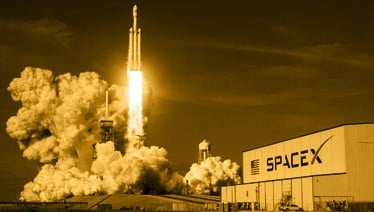Elon Musk, South African-born Canadian American investor, engineer, business magnate has successfully launched the Falcon Heavy into space, making this the most powerful operational rocket ever sent into space from earth.
The rocket launch is the first stage in Musk's plan to colonize Mars. Musk's plan involves building up a revenue stream using SpaceX's current fleet of reusable Dragon spacecraft and Falcon 9 rockets. This, Musk says, will provide the funding needed to move on to build Big F****g Rocket (BFR), SpaceX's most powerful rocket.
Musk envisions BFR as being able to fly people from one end of the earth to the other which will serve as the preparation for creating a Mars metropolis by 2024.
The timeline includes sending two cargo ships full of supplies to Mars in 2022 by SpaceX and then two more cargo ships plus two crewed ships to land on Mars' surface.
By aiming to landing humans on Mars Musk believes that the first steps in colonizing the Red Planet will be taken. The first steps in this process include the successful launch of the Falcon Heavy rocket test and the perfection of reusable rocket technology. With the February 6th launch the first step has been taken and the project is ready to move forward.
Tuesday Launch
On Tuesday SpaceX's Falcon Heavy rocket took off from Cape Canaveral in Florida. It soared into space, carrying Elon Musk's red Tesla Roadster. The rocket orbited into the asteroid belt and then landed in the ocean, showing the power that Musk has said that it would demonstrate and lending credence to Musk's plan to eventually send a rocket to Mars.
Two rocket cores touched down back on Earth after take-off, breaking away mid-flight. These outer boosters touched down approximately 1000 feet from one another in the Landing Zones 1 and 2 on SpaceX’s concrete landing pads. The center core was supposed to land on one of SpaceX's autonomous drone ships in the Atlantic Ocean but it missed its target.
The importance of SpaceX cannot be underestimated. It's not the world's most popular rocket, more powerful than that built by any country on earth. The launch also marks the first time a vehicle so powerful has ever been sent up by a commercial entity.
Spacex boasts 27 engines which, in combination, create a combined 5 million pounds of thrust at liftoff. Falcon Heavy has the ability to put around 140,000 pounds of cargo into lower Earth orbit – that's twice as much weight as that of any other operational rocket.
The success of the SpaceX's launch opens up new commercial opportunities including the option to use such a rocket as a national security satellite or, as Musk envisions, to send large groups of people into deep space.
Anticipation to Fruition
The launch of the SpaceX brings to fruition what has been on the drawing board for the last decade. SpaceX's plans to launch the Falcon Heavy Rocket were first discussed in 2011. At that time, the company's engineers thought that they'd be able to have the rocket in space in 2013 or 2014 but delays pushed it off until 2018.
In July Musk spoke about the difficulties of engineering the rocket. “It actually ended up being way harder to do Falcon Heavy than we thought. At first it sounds easy: just stick two first stages on as strap-on boosters. How hard can it be? But then all the loads change, the aerodynamics change.”
Plans
The first Falcon Heavy mission was meant to determine if the rocket could put objects into orbit. Musk donated his car as the object that would be tested and the launch proved the success of the vision. The top portion of the rocket carried the car. It ignited twice after it separated from the Falcon Heavy's boosters. The upper stage was put into a six-hour "coast" after the first burn to show that the Falcon Heavy could do a special type of orbit in which the Air Force was interested. This pushed the Tesla – Musk's car – into an orbit that could, potentially, send it way past mars.
During its coast the car passed through regions of intense radiation that surround Earth which is known as the Van Allen belts. Musk warned that this could be problematic for the rest of the mission because high-energy particles were bombarding the car and rocket throughout the coast. At a press conference before Tuesday's launch Musk explained that “The fuel could freeze, and the oxygen could be vaporized, all of which could inhibit the third burn which is necessary for trans-Mars injection.”
Yet everything was executed successfully, placing the car on a trajectory around the sun that will take it as far as the asteroid belt beyond the sun before being pulled back.
Launch Pad LC-39A
The Falcon Heavy was launched from pad LC-39A, the same pad that was used to launch the Apollo 11 mission to the Moon. The LC-39A has seen numerous Space Shuttle launches in recent years and now is expected to see numerous Falcon Heavy flights in the coming years.
Plans are for the Falcon Heavy to complete more missions this year including to launch a large Saudi Arabian communications satellite called Arabsat 6A and to send up a test payload for the US Air. Two additional communications satellites are scheduled as well.
Then, the goal is Mars!

